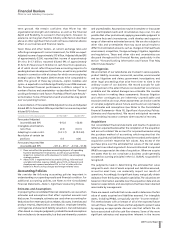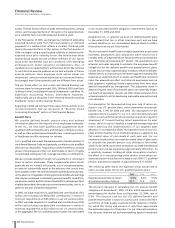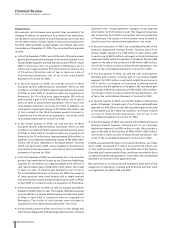Pfizer 2005 Annual Report Download - page 16
Download and view the complete annual report
Please find page 16 of the 2005 Pfizer annual report below. You can navigate through the pages in the report by either clicking on the pages listed below, or by using the keyword search tool below to find specific information within the annual report.
2005 Financial Report 15
Financial Review
Pfizer Inc and Subsidiary Companies
between Zoloft-treated children and adolescents and placebo
controls in their rates of suicide attempts or ideation.
•Neurontin, for use in adjunctive therapy for epilepsy, is also
approved in more than 60 markets for the treatment of a
range of neuropathic pain conditions. Neurontin has also been
approved for the management of post-herpetic neuralgia
(PHN), a painful condition that affects many people in the
aftermath of the viral infection commonly known as shingles.
Neurontin was the first oral medication approved in the U.S.
for the treatment of PHN. The introduction of generic versions
of gabapentin in the U.S. in late 2004 caused a 77% reduction
in Neurontin sales for 2005 as compared to 2004.
•Geodon/Zeldox, a psychotropic agent, is a dopamine and
serotonin receptor antagonist indicated for the treatment of
schizophrenia and acute manic or mixed episodes associated
with bipolar disorder. Available in both an oral capsule and
rapid-acting intramuscular formulation, Geodon has been
launched in 59 countries, where more than 7 million
prescriptions have been written for more than 1.3 million
patients worldwide. In the U.S., Geodon hit an all-time new
prescription share weekly high of 6.1% during December 2005
and is now the second-fastest-growing atypical anti-psychotic
medication. In 2005, total Geodon prescriptions grew 23%
compared to 2004.
The Clinical Antipsychotic Trials of Intervention Effectiveness
schizophrenia study, supported by the National Institute of
Mental Health and recently published in the New England Journal
of Medicine, confirms that Geodon is an effective anti-psychotic
and is less likely to worsen weight, lipids, and glucose metabolism
than other agents. In fact, Geodon was associated with some
improvement in these metabolic parameters. These findings are
noteworthy because of the higher prevalence of metabolic issues
among patients with schizophrenia and are consistent with
previous Pfizer-sponsored clinical trials involving Geodon.
•Lyrica was approved by the FDA in June 2005 for adjunctive
therapy for adults with partial onset seizures. This latest
indication builds on the earlier FDA approval of Lyrica for two
of the most common forms of neuropathic pain—diabetic
peripheral neuropathy, a chronic neurologic condition affecting
nearly three million Americans, and post-herpetic neuralgia.
Lyrica was launched in the U.S., Canada, and Italy in September
2005 and is now approved in more than 50 countries and is
currently available in more than 30 markets. Market penetration
has been rapid; after one and a half years of Lyrica sales,
Germany and the U.K. posted Lyrica sales shares of 14.5% and
11.5%, respectively, in the anti-epileptic drug market, surpassing
those of many established competitors in both countries. Since
its September 2005 launch in the U.S., more than 500,000
prescriptions have been written for Lyrica as of December 23,
2005. Lyrica has already gained more than a 7% new-
prescription share of the U.S. anti-epileptic market as of
December 23, 2005, continuing its performance as one of
Pfizer’s most successful pharmaceutical launches.
Clinical evidence favorable to Lyrica continues to accumulate.
The September 2005 edition of Epilepsia focused on the
medication’s lack of interactions with other drugs. The
December 2005 edition of Epilepsia published a study showing
a significant seizure reduction in line with that seen in the three
previously published pivotal epilepsy studies.
•Celebrex and Bextra
On April 7, 2005, the FDA announced a decision to require
boxed warnings of potential cardiovascular risk for all COX-2
pain relievers and all prescription NSAIDs, including older non-
specific drugs such as ibuprofen and naproxen. On July 29,
2005, Pfizer and the FDA finalized the label changes for Celebrex.
The final U.S. label contains a boxed warning of potential
serious cardiovascular and gastrointestinal risks for Celebrex that
are consistent with warnings for all other prescription NSAIDs.
The boxed warning provides that Celebrex is contraindicated for
patients who recently have undergone coronary artery bypass
graft surgery. The label recommends that Celebrex be prescribed
at the lowest effective dose for the shortest duration consistent
with individual patient treatment goals. Pfizer is continuing to
conduct additional clinical studies evaluating the benefits and
risks of Celebrex. Pfizer is supporting Cleveland Clinic’s 20,000
patient prospective study to definitively evaluate the relative
safety of Celebrex and two older pain medications in patients
with heart disease or at high risk of heart disease.
In June 2005, the Committee for Human Medicinal Products
(CHMP) concluded its COX-2 referral process and recommended
that both Celebrex and Dynastat (parecoxib) remain available
to patients. The European Medicines Evaluation Agency (EMEA)
has required new labeling for all COX-2 drugs that includes a
restriction on use for patients with established heart disease or
stroke and additional warnings to physicians regarding use in
patients with cardiovascular risk factors. This new labeling was
implemented for all COX-2 medicines across the E.U. in July of 2005.
The market for pain relievers has changed since the withdrawal
of Vioxx in September 2004. Sales of Celebrex began to decline
in late 2004 due to physician and patient concerns surrounding
selective COX-2 inhibitors. Also contributing to the decline in
sales of Celebrex was the voluntary suspension of DTC
advertising in the U.S. beginning in December 2004. Pfizer
plans to reintroduce branded advertising in 2006, in alignment
with our new DTC advertising principles, highlighting Celebrex’s
unique clinical profile and benefits.
In September 2005, with full implementation of revised labeling,
Pfizer began to focus renewed attention on Celebrex, with the
goal of making the pain reliever available to increased numbers
of patients. In July 2005, the FDA approved a sixth indication
for Celebrex—ankylosing spondylitis—a form of spinal arthritis
that affects more than one million people in the U.S.
In April 2005, the FDA decided that while Bextra’s cardiovascular
risk could not be differentiated from other NSAIDs, the
additional, increased risk of rare but serious skin reactions
associated with Bextra, already described in its label, warranted
its withdrawal from the market. In 2004, we recorded $1.3
billion in revenue for Bextra. We respectfully disagree with the
FDA’s position regarding the relative risk/benefit profile of
Bextra. However, in deference to the regulatory agency’s view,
we suspended sales of the medicine. In addition, at the request
of European and other regulators, we suspended sales of Bextra
in the E.U., Canada and many other markets around the world.
In connection with the decision to suspend sales of Bextra in
the U.S., the E.U., and certain other markets, we recorded
certain charges totaling $1.2 billion ($769 million, net of tax)
in 2005. These pre-tax charges included $1.1 billion related to
the impairment of developed technology rights associated
with Bextra and $5 million related to the write-off of machinery
and equipment, both of which are included in Other
























